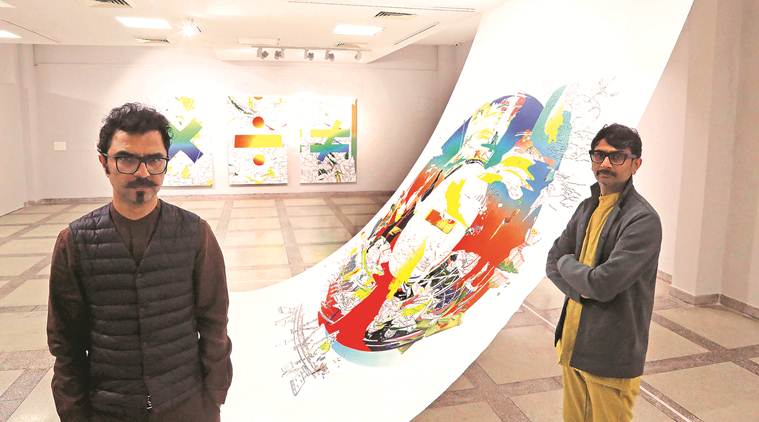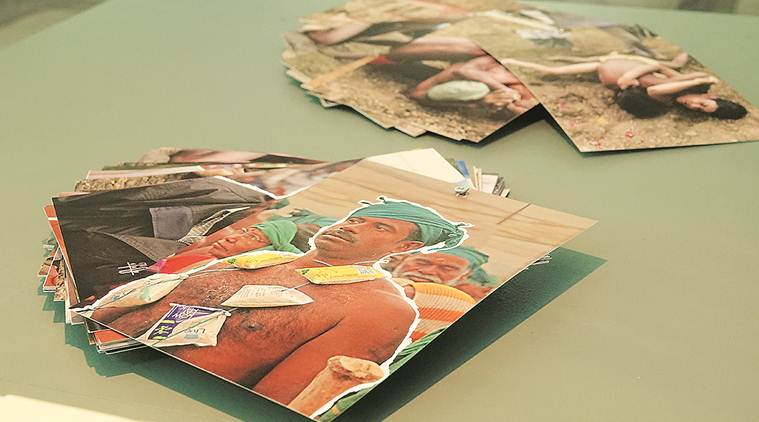Written by Parul |Updated: February 23, 2019 12:30:20 am
Stories of the Soil
Artists Jiten Thukral and Sumir Tagra come closer home, to Punjab, with their exhibition to express the complex economic, social, political and personal crises faced by the farmers.

Why are the farmers protesting? Are our policies to be blamed for the agrarian crisis faced by farmers in India today? What is the criteria of satisfying hunger? What will happen when we have no soil to sow? Are we all illustrated differently? Do we live in the surreal? Can an artwork change your life? These are some of the 250 rapid-fire questions that artists Jiten Thukral and Sumir Tagra posed to the audience as a prelude to the opening of their exhibition ‘Farmer is a Wrestler’ in Chandigarh, at the Punjab Lalit Kala Akademi.
For both Thukral and Tagra, whose show opened this week, it is a sort of a homecoming. Thukral was a former student at the Government College of Art, Chandigarh. It is here, outside the principal’s office that he met Tagra, who was seeking admission in the same college. Tagra eventually joined College of Art, Delhi, which later Thukral joined for his Masters in Fine Arts. “There are mysterious ways in which life works and gets people together. We met in the late ’90s, kept in touch, informally shared many artistic ideas and our work over the internet, communicated and connected and eventually began working together in 2001, and the rest as they say is history. We work collaboratively with a range of media, be it painting, sculpture, video, design, interactive games, each material resonating our concerns, issues of today, the times we live in and the change we are experiencing,” shares Thukral. Their work, adds Tagra, attempts to be an immersive experience, with new formats of engagement constantly created to widen the scope of art and making it real and approachable for common people to feel, touch, interact with, and most importantly, question and think.

Consumer culture, migration, memories, AIDS, Indian mythology, education, urban design and architecture — the grammar, philosophy, approach and treatment of their practice is constantly shifting and evolving with research and observation resulting in varied expressions. The language is diverse, playful, abstract, using wit, humour, colour, to comment and draw attention to concerns, all a process of evolving, and as Tagra describes, the core of the practice is being conscious and humble. “As artists, we cannot work in isolation. Our work has to reflect social change and as part of our artistic journey, negotiate ideas daily to trigger questions and also ask ourselves as to what force we are with,” says Tagra.
‘Farmer is a Wrestler’ has emerged from a project titled, ‘Escape for A Dreamland’, which was based on the issue of people leaving their homes to move abroad — a desire to ‘escape’ via migration and changing middle-class aspirations. The sprawling old houses of Punjab, vacant and desolate, became their contexts, as the artists wanted to look at migration from a sociopolitical point of view. A research done at Punjab Agricultural University said that water will get over in Punjab in a few years. Their association with the Akal Academy Baru Sahib and farmer suicides started research work for a project that could draw attention to the urgency of the agrarian crisis faced by farmers in India today. The artists travelled to Sangrur and many villages in Punjab to meet the families of farmers who had committed suicide, to photograph them, with a researcher ready with a list of questions and video equipment. “The first home we went to, the farmer’s wife came and sat with the photograph of her dead husband in her lap. We could not speak a word, take a single picture or do anything. We visited many homes across Punjab and Haryana, where so many farmers had killed themselves because of debts, with money-lenders adding another dimension to the tragedy. We became part of farmer protests to come closer to their lives, and the biggest protest by as many as one lakh farmers in Delhi was largely ignored by the media. It reported only about the number of police personnel present there. We spoke to scientists about soil, seeds, climate change and also studied the divisions of land, people selling their land to go abroad and knew that this was an issue that concerned all and there was an urgency to create awareness through art and also for people to understand this crisis. We order food online, eat in our air-conditioned rooms, oblivious of what is happening outside and how the lives and livelihood of farmers are in danger,” explains Tagra.
Connecting the two projects with an akhara, the title of the exhibition draws parallels with kushti — a form of traditional Indian wrestling that is popular among rural communities. Thukral’s father maintains an akhara in Jalandhar and the two artists use the metaphor of the game which is about physical and mental struggle and relate it to the farmer’s fight and struggle for survival. “Soil, land, labour and muscle, these are some of the many symbols here. And the irony is that the top prize in a kushti match is a tractor,” reflects Thukral.
Drawings on Swaminathan Commission Report — Serving Farmers and Saving Farming, form a large panel in the exhibition hall, with the copies of the report for people to read. There’s also a documentary titled Kisan Mukti March, which plays opposite this panel. Then there’s an oil on canvas titled Distress Mathematics and an acrylic on canvas titled Distress Equation — both pose many questions on the economics of farming. Other works include an installation titled Bubble Under The Table, using fibre glass, nylon sheet and books, a short fictional film set in the akhara, a sculpture Swantantur Singh, which depicts the trying conditions farmers have to work under. The exhibition has a multitude of layers and meanings. “Our work has a lot to do with colour, but for this exhibition we dropped colour from some paintings, for we wanted people to fill in the colour this time in their mind. In the bold strokes, you will see hope, strength, determination and decisions. The artistic process is about being more aware, raise an issue and questions. Being fearless yet fragile, we are aware of the failures and force,” sums up Tagra.
The exhibition is on till March 5, at Punjab Kala Bhawan, Sector 16, Chandigarh






















No hay comentarios:
Publicar un comentario